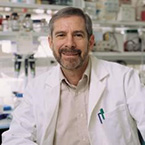
A leader in the field of preventive cancer vaccines, Dr. Lowy is well known for his papillomavirus research, conducted in collaboration with Dr. John T. Schiller. Their initial studies characterized papillomavirus nonstructural genes, especially the three viral oncogenes, E5, E6, and E7. Their subsequent research on the structural viral genes developed technology that underpins the FDA-approved virus-like particle human papillomavirus (HPV) vaccines: Gardasil (approved in 2006), Cervarix (approved in 2009), and Gardasil 9 (approved in 2014). These vaccines counteract HPV infections, responsible for approximately 5% of human cancer worldwide, including virtually all cervical and anal cancer, and a high proportion of vaginal, vulvar, penile, and oropharyngeal cancer.
Dr. Lowy’s recent research is focused on understanding the papillomavirus life cycle, elucidating the mechanisms by which HPV vaccines induce strong protection against HPV infection and disease, and exploring the potential for additional vaccines. Dr. Lowy’s recent research has shown that HPV initiates its life cycle by first binding to the acellular basement membrane at sites of disrupted epithelial cell barrier function before transferring to the target epithelial cell, a finding that contradicts the normal first step in a viral life cycle whereby the virus first binds to its target cell. This research has proven that high vaccine efficacy is attributable to the immunogenicity of the vaccine and to the disrupted tissue barrier at potential sites of infection, which promotes exudation of neutralizing antibodies and the exquisite sensitivity of HPV to such antibodies.
He has also investigated the function of signaling molecules shown to be influential in the regulation of neoplastic growth, centering on defining the function of Ras oncogenes mutated in more than 25% of human cancers. More recently, he has studied the molecular aspects of the tumor suppressor gene, DLC1, which is frequently deleted or down-regulated in a wide variety of cancers. His research in this area has demonstrated that in addition to its catalytic function, DLC1 is important for the regulation of protein scaffolding, protein-protein interactions, angiogenesis, apoptosis, migration, and metastasis and that phosphorylation regulates its activity and role as a tumor suppressor. He aims to define the molecular mechanisms by which such proteins induce and suppress cancer to allow for the development of new molecularly targeted therapies.
Career Highlights
2021 AACR Margaret Foti Award for Leadership and Extraordinary Achievements in Cancer Research
2021 AACR Distinguished Public Service Award
2019 Elected Member, National Academy of Medicine
2019 AACI Distinguished Scientist Award
2018 Science of Oncology Award and Lecture, American Society of Clinical Oncology
2017 Lasker-DeBakey Clinical Medical Research Award
2015 Harrington Prize for Innovation in Medicine
2014 U.S. Presidential National Medal of Technology and Innovation
2013 Research and Hope Award for Academic or Public Research, National Cancer Institute
2011 Albert B. Sabin Gold Medal Award, Sabin Vaccine Institute
2009 Elected Member, National Academy of Sciences, Washington, D.C.
2009 Distinguished Medical Science Award, Friends of the National Library of Medicine
2007 Medal of Honor for Basic Research, American Cancer Society
2007 Nathan Davis Award, American Medical Association
2007 Clinical Immunology Prize, Novartis
2007 Humanitarian Award, American Skin Association
2007 Dorothy P. Landon-AACR Prize for Translational Cancer Research
2007 Federal Employee of the Year Service to America Medal, Partnership for Public Service
2003 Elected Member, Institute of Medicine
1968 MD, New York University School of Medicine
[Institutional affiliations listed for Fellows reflect those held at the time of their induction into the AACR Academy.]